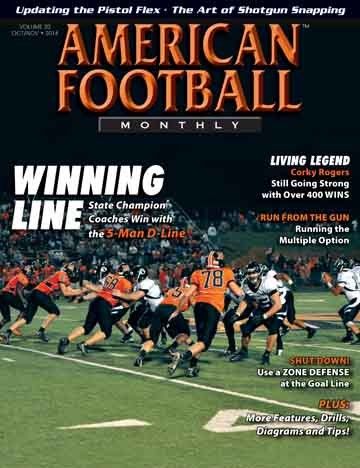Five on the Line - The 5-man defensive front is making a comeback – especially against traditional run-first offenses.
by: JohnAllen W. SnyderOffensive Coordinator • Pequea Valley High School (PA)©
More from this issue
Before the advent of today’s high-powered spread offenses, it was common for defenses to employ a 5-man front with a nose guard, two tackles and two ends. While many teams have gone away from 5-man fronts, AFM found a surprising number of 2013 state champions that use the front either exclusively or part time.
Here, coaches from four championship programs share their insight and strategies for making the 5-man front effective, especially against the run. They are Matt Crossman, defensive coordinator of New York Class A champion Queensbury high School; Scott Mahoney, head coach of New Jersey North 1-Group 1 champion Pompton Lakes High School; Lorne Ridenour, defensive coordinator of Maryland Class 2A champion Middletown High School; and Cole Meacham, head coach of Utah Class 2A champion Manti High School.
How do you use the 5-man front in your defense? Is it a traditional pairing of tackles and ends with a nose guard or something different?
Crossman - We are a traditional 5-2 man front. Things are a bit different with our linebackers but defensive line wise, we typically have a nose guard head up on the center, two 3 techniques shaded to the outside eyes of the guards, and our defensive ends are aligned in what we call “shoulder pad to shoulder pad” outside of the tackles. (Diagram 1). If an offense is not in a balanced formation, we will adjust our front to the strength.
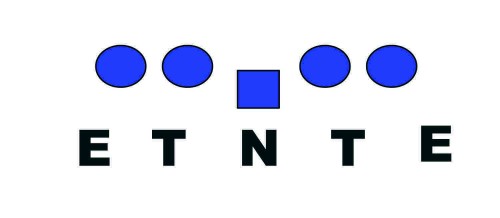
Diagram 1: Queensbury Base Front
Meacham - We keep it traditional. When we are in a 5-man front, our nose guard will shade the center to the strength or tight end. Our strongside tackle will be in a 4 technique on the offensive tackle’s inside eye. This puts that tackle in a bind with our strongside defensive end when we line him up inside of the tight end. To the weak side of the formation, our tackle aligns in a 3 technique to the outside eye of the guard and our defensive end aligns to the outside eye of the tackle (Diagram 2).
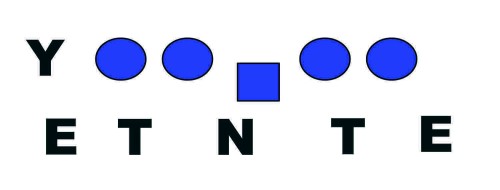
Diagram 2: Manti 5-Man Front
Mahoney - We play with at least one linebacker on the line of scrimmage, sometimes even two, depending on our personnel. That’s the key to this defense. If we didn’t have a linebacker that can play on the LOS, we wouldn’t play a 5-man front. Our defense the past few years has been a modified 4-3 under look. We have been fortunate to have the right pieces for that defense. This season we are playing more of a 3-4 look. But they both are very similar and most people can’t tell the difference. We want to move guys around and create havoc up front. We always adapt it to our personnel that we have in a given season but our main goal is to stop the run and confuse the offensive line. Our defensive coordinator Paul Koontz does a great job of putting our guys in the right position to plug up that offensive line and keep them from getting to our linebackers (Diagram 3).
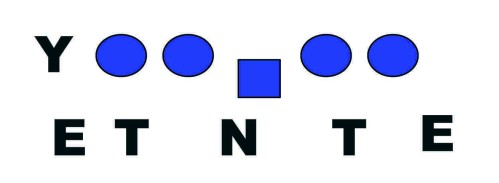
Diagram 3: Pompton Lakes Base Front
Ridenour - We are traditional in the number of linemen we use (5) but different in their alignment. The nose and tackles are aligned head up on the center and two guards. Our ends align outside the offensive tackles (Diagram 4).
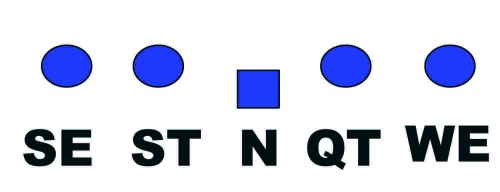
Diagram 4: Middletown Base Front
Our front stays in the same alignment and position all the time. This allows us to play comfortably to all offensive schemes. Our theory is to not game plan week to week by creating a new defense to stop certain teams. Rather, we want to game plan to win the state championship and to do that at the end of the season you have to stop the run.
What are the advantages and disadvantages of using the 5-man front?
Meacham - The advantages for us have simply been based on personnel that we have on the team in that given year. We found ourselves having a number of quality defensive linemen and a few linebackers. We decided that in order to stop the run in our league we had to put the best players on the field and if that meant more defensive linemen, then so be it. Another advantage is when a team gets into spread sets or based on down and distance. If it’s a passing down, we can typically get a good pass rush by forcing the offense to block us one-on-one and hoping that we can win that battle.
It can be a disadvantage because we have fewer guys behind the front in coverage. This is detrimental if a team wants to consistently spread us out. In that case we back out of it and get into our base front which is the 4-4.
Mahoney - The advantages for us are very simple. It is great against the run, and that’s our main focus. We love it in that regard. It’s the best defense against a pro style, two-back offense. As long as your strong end is a linebacker type, there isn’t one play that will hurt you from a scheme perspective. The only disadvantage is when a team motions a back out as a receiver to the weak side. That puts you in a position of weakness. Other than that, there isn’t one play or formation that we haven’t shut down from that personnel grouping, and we have seen it all. You just have to match up your front and coverage with what they like to run. You must have great defensive ends and linebackers. They have to be able to adapt to the spread sets that are in football today. We like to adapt our fronts and move guys around.
Ridenour - We have the philosophy that every single play - run or pass - starts with the center and we want to disrupt that start point as much as possible. Our nose has to be a disruptive player. If not, then we have no business being in a 50 front defense.
Some disadvantages we have seen are when you have a defensive tackle that plays too high. This hurts us because the offensive lineman can get movement there and really stress the front at that point. Also, if you have a defensive end that loses contain it really can put you in a bind.
Crossman - Advantages for us specifically are that not a lot of people are running this defense in our league. It has the same effect as option teams do where you don’t see it a lot so you don’t practice against it a lot. Now offenses are forced to work against it in a one week long window of time. That can be difficult. We believe that the defensive system we use is very easy to teach. Finally, I would say that it goes well with any formation that we typically see in a season’s time. All of these things allow us to play fast and free. The biggest disadvantage in this defense and front specifically is the influx of the spread offense. It can cause us problems with coverage on so many receivers.
When do you use the 5-man front? Is it related to specific down and distance situations or do you use it all the time?
Mahoney – Down and distance can play a part in it. We align first and foremost by the offensive formation. The more guys you put in the backfield, the more guys we are going to put in the box. Two backs and a tight end on a non-passing down is an automatic 5-man front. If it’s two backs and no TE, we will play either a 5 or 4-man front, depending on down and distance and offensive tendencies. One back is almost always a 4-man front. We can use the 5-man front versus one back but your coverage choices are limited so we usually like to check to a 4-front.
A good offensive coordinator can motion to different looks and really put you in a bind. When you are in a 4-man front you can handle any formation or motion and have the flexibility so the offense doesn’t know exactly what you’re doing. It’s simple numbers and we determine all of this through the breakdown of the game plan. If a team wants to spread us out, we will move the defensive end out and show a 4-man front. Our ends must be hybrid players. They have to have the ability to stop the run and play the pass also.
Ridenour - We use it all the time. My mentor, Lynn Carr, who I learned this defense from years ago, convinced me that you have to stay in one front to win. It’s just what we do. We have all bought into it and support it. We feel that sticking to our guns helps us win those big games, and playoff games in the long run. Our kids are confident in what we do and what they are asked to do. We feel that is better than playing without confidence in a number of different looks.
Crossman - I like to stick with this front as much as possible. When you have to rotate guys in or out or play based on situations, we feel like that it allows the opportunity for our kids to think and that’s not what we want. I want our kids to play fast and not think but go and make the play. Another reason we like to stay in this front is because it’s less that our kids have to learn week in and week out. That allows us to do what we do each week. We will tweak things here and there based on the team we are facing but overall I would say we like to stay in this front the entire game.
Meacham - No, it is not our base front. When our kids come in as freshmen we install the 4-4 as our base front (Diagram 5).
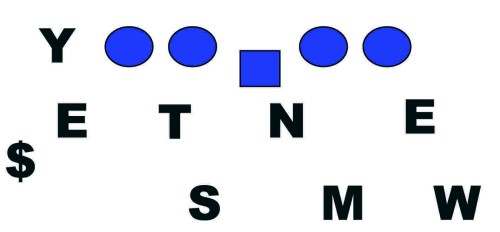
Diagram 5: Manti Base Front 4-4
This allows us to be teaching the same concepts the whole way through a player’s career. Given the situation or the team, we will move into the 5-man front when it best suits us as a defense. We feel that if we are going against a team that is consistently trying to spread the field, we can’t stay in a 5-man front all the time. That’s why we have the base to fall back to.
What types of personnel do you need to be effective with this front?
Ridenour - Each position has a set of characteristics that we want to embody based on where they line up. Our nose has to be a disruptive player, willing to get into the center and disrupt his plan of action. We feel this can help disrupt everything else also. I preach to our noses every day to “create havoc”. We want them to get both hands on the center and penetrate that line of scrimmage. Our strong tackle is typically someone we feel is a bigger “plugger” type player. He is not as quick as our other linemen but it is very difficult to blow him off the ball.
Our quick tackle, as we call him, is someone we like to move around and stunt and blitz. He has to be a quicker player than our strong tackle. Our strong end needs to be someone who is a physical player that can play on the line of scrimmage but also versatile enough to play the pass as well. Our weak end or “Willy” is our most versatile player. He must be able to squeeze that D gap along with being able to play in space. He is our “do everything” player.
Crossman - We are a bit different in this regard. A lot of teams want to have big defensive linemen. Often that means we have to play our offensive linemen on defense. This isn’t something we want to do if we can avoid it. It also allows us to get those tweener-type kids who are too small to play offensive line but not quick enough to play linebacker into the game and have a role on the team. We see this as a huge advantage.
In talking about our nose guard and defensive tackles, we look at these guys as interchangeable. We typically want smaller linemen somewhere around the 190-200 pound range. These guys have to be quick and use their speed and leverage. We have been fortunate to have very explosive kids in these positions in the past few years. Our defensive ends we call “monster” defensive ends. These guys have been around 6’5”- 6’6” most seasons. We want guys with a good rangy frame, who have speed. They have to have speed because they are responsible for outside contain and perimeter run plays.
Meacham - For the nose, we like to have two different types of kids. Not only does that give us some depth but also this type of player allows us to do different things. First, we want to have that big hole plug kid who can handle two gaps. We coach him up in the sense that we tell him to drive the center’s butt into the weak side A gap and cause havoc. Other times when we see a more pass-oriented offense, we will bring in a smaller, quicker kid to get past the big, slower offensive linemen. Often we will bring down the linebacker and stick him there.
With the tackles, our defensive line coach emphasizes “hands on the guy.” We feel when we consistently get our hands on the offensive linemen, we can disrupt them and it allows our linebacker to make plays. We talk consistently about hands on. The strongside defensive end has to be a bigger kid who can’t get washed down by the tight end. He has to keep that gap integrity and not let the offense compress it. On the weak side, we want to squeeze that tackle down and shrink the B gap.
Mahoney - You have to be able to fit the best thirteen or so players into your defensive package. We found that once you identify those guys, then you can adapt the scheme to fit their strengths and then just work to improve their weaknesses. If you have smaller defensive linemen, get them moving with stunts, twists, slants, etc. You can put your bigger linemen in front of smaller linebackers.
For the nose position, we want an athletic, quick player. We like to move him around and slant him in different directions. Ideally, our noses are 210 pounds or less. Our tackles need to be mobile enough to get in the hip pocket of the guards when they pull. That’s key for us in evaluating talent there. They also have to be big enough to swallow up blockers to protect our linebackers.
For our ends, we need athletes that can stop the run but also get into pass coverage. We teach them to use their hands every day and we want to funnel everything back inside to the big guys. If we can’t do that, we teach them to string everything to the numbers.
What are the responsibilities of each position within the 5-man front?
Meacham - Our nose is a two-gap player trying to control both A gaps. The strongside defensive tackle aligns in a 4 technique and maintains that gap while not getting down-blocked by the tackle. We want this kid to mess up their blocking schemes between the guard and tackle. The weakside defensive tackle is responsible for securing the B gap to his side. The strongside defensive end is aligned on the inside eye of the tight end and wants to maintain gap integrity here. We cannot get down blocked by the tight end. Our backside defensive end wants to squeeze that B gap down by getting in the tackle’s hip (Diagram 6).
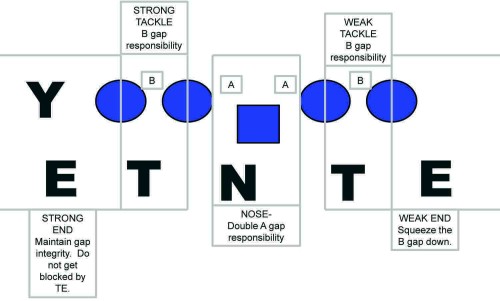
Diagram 6: Manti Gap Responsibilties
Mahoney - We want our linemen being one-gap players as much as possible. We teach all the line of scrimmage players to attack the man they line up on and close down all gaps. They all react to the movement of the ball. “Two-gapping” takes away the aggressiveness of those guys. That is always bad. Even when we align our guys head up, our way of two-gapping is much different than others and we usually are baiting offensive linemen for some type of stunt.
Pre-snap, our inside linebackers are responsible for two gaps, but become one once we get flow from the backs. Our defensive scheme forces teams to run where we want them to run to. That is, the outside. We don’t allow teams to run up the middle. We spill everything to the sideline and to our force players.
Our nose is a two-gap player, and we often slide him to the strength of the formation. The tackles are in those positions to stop the straight ahead running plays we see often. The ends when they are aligned on the LOS are responsible for what we call the “inside”. We use this term when talking about any sort of zone read play. Here we coach the defensive ends to take anything inside, which would be the back and we let the linebackers and the strong safety worry about the “outside” or the quarterback (Diagram 7).
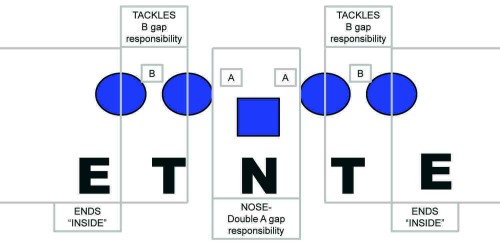
Diagram 7: Pompton Lakes Gap Responsibilities
Ridenour - Our nose is a two gap player whose directive is to cause havoc within the center to the quarterback corridor. The tackles, both strong and quick, are B gap players that we teach to squeeze the C gap. The defensive ends, because they are so multifaceted, are used to control the D gaps but also work in space (Diagram 8).
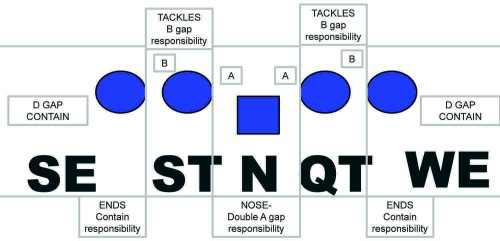
Diagram 8: Middletown Gap Responsibilities
Crossman - Our nose and tackles are tied to the linebackers behind them in gap responsibilities. The nose will have either the strong/weak A gap to either side of the center and the defensive tackles will be responsible for their respective B gap. Our defensive ends are responsible for C gap on out. They are our contain, edge players. That’s why we want them to be able to run and have that good frame on them (Diagram 9).
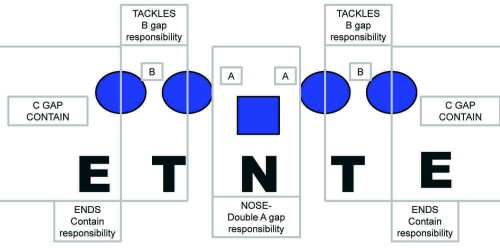
Diagram 9: Queensbury Gap Responsibilities
How are your linebackers positioned and what are their general responsibilities?
Mahoney - The two most important players to find are the strong and weakside linebacker. The strong linebacker must be tough enough to play on a tight end and athletic enough to play pass. The weakside linebacker must be tough enough to play in the box but athletic enough to play the deep half or third responsibility and cover slot receivers in certain coverages and formations. If you are fortunate enough to have those two players, you can play any front and coverage you want.
Ridenour - When we play against an under center team, we align our linebackers at four and a half yards depth. Versus a gun team they are at five and a half. They are taught that if the play is away, they are responsible for the off A gap and any flow back to them. If the play is to them, they have C gap control. They must pursue the ball inside out and stay square to the line of scrimmage. In order for our defense to be successful, we need linebackers that can defeat the guards. We feel that our LBs should be in on 80% of all tackles (Diagram 10).
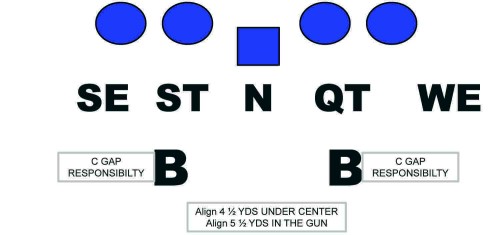
Diagram 10: Middletown Linebacker Alignments
Crossman - This is where our front may be different than most other 5-man fronts. Here we call our two linebackers tandems in that we base them as stack linebackers, one on top of the other. Our Mike (M) is your traditional plugger, responsible for stopping the run. He aligns around three yards from our nose, stacked over him. Our hybrids (H) base alignment is eight yards stacked on top of the Mike linebacker. This allows us to cover all gaps in the run game with our 5-2 front (Diagram 11).
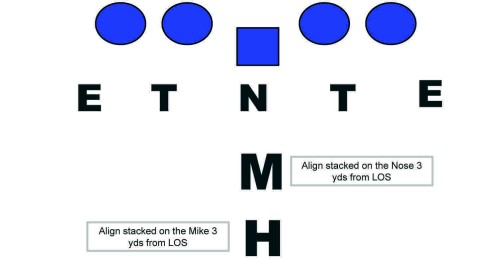
Diagram 11: Queensbury Linebacker Alignments
Meacham - When we are in the 5-man front, we have an inside linebacker and two outside linebackers. The inside linebacker’s responsibilities are to make plays within the tackle box. Ideally, our front will eat up the linemen and we can be free to run and make plays. Our outside linebackers will remain right at the edge of the box in order to fold in and help on run plays but also still be able to contain the play as well. Contain responsibility falls on them (Diagram 12).
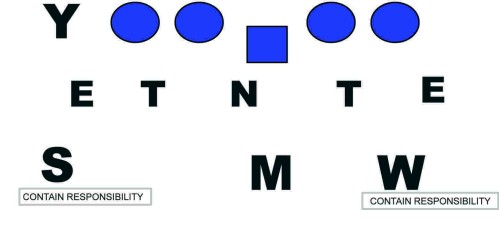
Diagram 12: Manti Linebacker Alignments
Does your front or alignment change based on the formation the offense comes out in? For example, how do you line up against a 2 x 2 balanced formation compared to a typical pro I formation?
Crossman - We align to the balanced set in our 5-2 with our linebackers in the base tandem look. Our secondary, the corners and safeties, play man-on their receivers. The one thing I will do depending on who it is that we play and their personnel versus ours is change the levels of the secondary. Sometimes we will be pressed up on the receivers and other times we won’t be. Our front remains the same. Our nose is head-up on the center, defensive tackles are in shaded three techniques and our ends are shoulder pad to shoulder pad containing their gaps. The two linebackers will be stacked three yards (Mike) and eight yards (Hybrid) from the line of scrimmage. Typically I will shade the Mike just a big to the left so he can see his reads better and the hybrid a bit to the right for the same reason.
With the pro I formation, we will align slightly differently. What stays the same is the secondary. Everyone is still locked onto their man if they have a receiver to their side. The safety with no receiver will walk down outside the box as another contain/edge player for run support. The defensive end to the tight end will align head up on the tight end controlling the C gap and containing that side. The defensive tackle beside him will slide over to the inside eye on the tackle still controlling the same B gap. The nose will shade the center toward the tight end and he is now responsible for that A gap. The backside defensive tackle and ends will remain the same. Our linebackers are no longer set up in the tandem base look as they are against a balanced set. Here the Mike will align in a 50 technique on the outside eye of the strongside tackle. Our hybrid linebacker will align in a 20 technique and be responsible for the backside A gap. This allows us to be gap sound to the types of plays a power I team is typically going to run (Diagram 13).
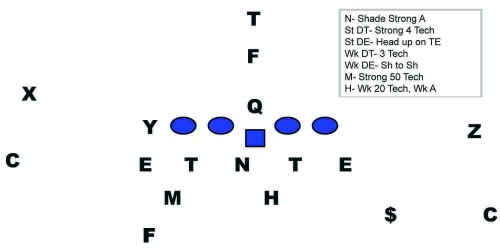
Diagram 13: Queensbury 5-2 vs. Pro I Formation
Meacham - If a team does this only once in a while (2 x 2) then we would stay in our 5-man front, but if it’s a large part of their offense, then we would move out of the 5-man front to our base 4-4 look. It allows us to cover people better when we are being spread out. If we get a pro set, we would align to the strong side (TE) and stay in our 5-man front.
Mahoney - We will almost always check to a four man front or even a three. If you stay in a five front, you basically can either play quarters or man. We are not a man coverage defense, only in special situations and even then it’s not traditional man coverage. Either way, you’re going to get shredded in it if you stay. By moving to a four front we can play about four or five different coverages per game. You need that freedom because that is a formation that can hurt you so you need to be able to make adjustments as needed.
Versus the spread look of a 2 x 2 formation (Diagram 14) we will move the ends out in order to ensure we are covered correctly. Out of a pro set, we would sit in our 5-man front and force a team to beat us up front to score (Diagram 15).
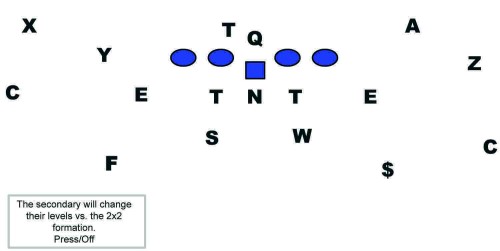
Diagram 14: Pompton Lakes 5-2 vs. 2 x 2 Balanced Formation
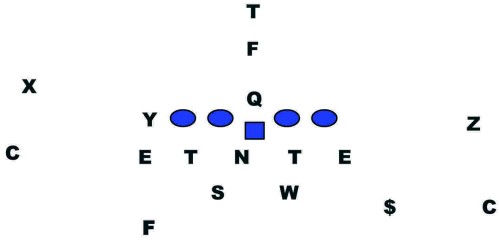
Diagram 15: Pompton Lakes 5-2 vs. Pro I Formation
Ridenour - We will widen our ends in a spread look to split the difference of the end man on the line of scrimmage and the slot receiver. We also play cover two over the top of it as well. Versus a pro set we will stay in our base and play our defense. We want our opponent to get into this type of a set so we can dig in and get physical with them.
In your 5-man front, what front movement do you do, if any, or what types of blitz packages do you use?
Mahoney - We give a lot of different fronts/alignments per game. We can slide the line strong, weak, or in a bear front. We like to run stunts from our DL, so we can keep as many guys as possible back on pass coverage. However, the nice thing about having a linebacker as one of the five is he can cover backs or a tight end. This allows you the freedom to blitz a linebacker and still have six in coverage. The way we play the five gives us an easy way to change on the fly. A simple adjustment for our kids ends up looking like a totally different defense on film. Our opponent never truly knows what defense we will be in and it usually isn’t the same as the week before. That is how we counter the offenses we see. When they call a play, we check to something different. It’s easy and efficient to get into all of our looks.
We have a set group of pass pressures and run specific pressures that we will use in a given situation. Some basic ones that we do right off the bat are a tackle and nose twist. Given our front, we can do this to either the strong or the weak side (Diagram 16). Another one we like is an X stunt between the tackle and linebacker behind him (Diagram 17). We try to keep the offenses guessing.
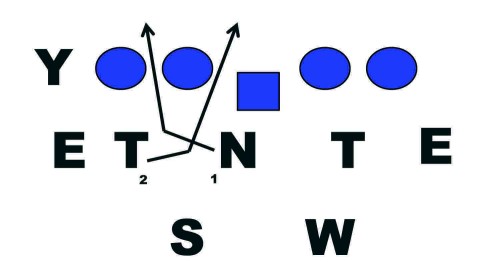
Diagram 16: Pompton Lakes Twist Stunt
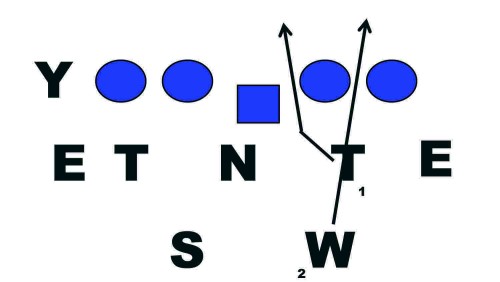
Diagram 17: Pompton Lakes X Twist Stunt
